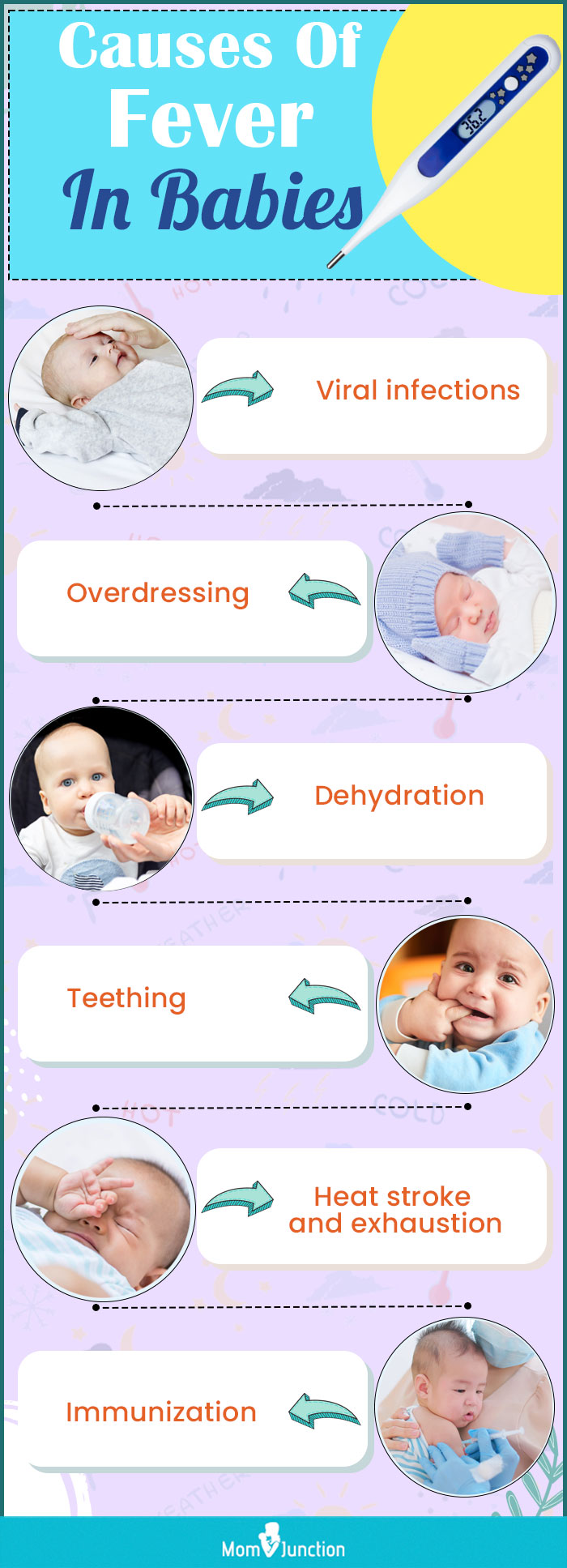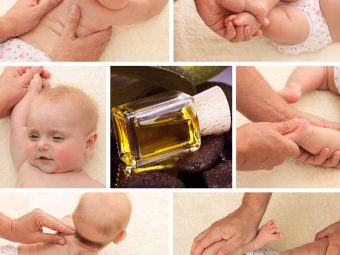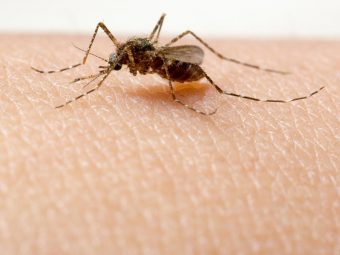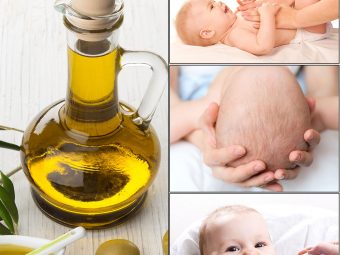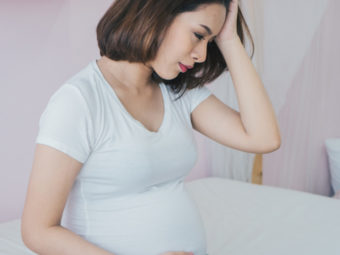
Image: ShutterStock
Fever in babies can make the parents worried, while the infant stays in discomfort. A high body temperature in babies indicates that something is amiss with their body and should be addressed by a doctor.
This post discusses some of the prominent causes of fever in newborns, how to care for a baby with a fever, and preventive strategies to avoid a fever in the first place.
What Temperature Is A Fever For The Baby?
A fever is the condition when the brain increases the core body temperature from normal.
The American Academy of Pediatrics (AAP) defines fever in infants as a body temperature higher than 100.4°F (38°C) (1). The normal body temperature range of the baby is between 97.5°F (36.4°C) and 99.5°F (37.5°C). However, there are several ways of measuring a baby’s body temperature , based on which the definition of a fever can vary.
 Point to consider
Point to considerThe table below shows you the normal temperature range and the fever temperature in infants (2) (3):
| Measurement method | Normal temperature range | Fever temperature |
|---|---|---|
| Rectal (rectum) | 97.9°F to 100.4°F (36.6°C to 38°C) | Higher than 100.4°F (38°C) |
| Axillary (underarm/armpit) | 94.5°F to 99.1°F (34.7°C to 37.3°C) | Higher than 99.1°F (37.3°C) |
| Temporal artery (forehead) | 96.4°F to 100.4°F (35.8°C to 38°C) | Higher than 100.4°F (38°C) |
| Tympanic (ear) | 96.4°F to 100.4°F (35.8°C to 38°C) | Higher than 100.4°F (38°C) |
| Oral (mouth) | 95.9°F to 99.5°F (35.5°C to 37.5°C) | Higher than 99.5°F (37.5°C) |
Temperature from the armpit is the least accurate and that from the rectum the most precise. Body temperature between 100°F to 100.2°F (37.7°C to 37.8°C) is considered a low grade or mild fever in babies (4). Temperatures above 100.4°F (38°C) are high-grade fevers.
Nevertheless, if the baby’s temperature is over the normal body temperature range, then it is best to take the infant to a doctor to find out the reason behind the fever.
 Quick fact
Quick factWhat Causes A Fever In Babies?
A fever is a symptom of numerous diseases and conditions. According to the AAP, approximately ten percent of young infants who develop a fever have a urinary tract infection as the underlying cause. Some other prominent causes of fever in babies include:
- Viral infections: The brain responds to the presence of a virus in the body by raising the body temperature. Certain viruses, such as the malaria virus, can cause the baby’s fever to come and go (5).
- Bacterial infections: When the immune system detects bacteria in the body, it signals the brain to increase the core temperature. A fever also occurs when the bacteria release toxins into the bloodstream.
- Immunization: Fever could be noted as a side-effect of vaccination. Infants get immunized for several diseases and may display a rise in temperature after vaccination. However, immunization fevers are low-grade and temporary and usually go away in a day.
- Overdressing: An overdressed baby may have a warm body or forehead, but no fever. However, leaving a baby swaddled in layers of clothing, especially during summer, may eventually cause a fever.
- Dehydration: Low fluid intake and dehydration (due to vomiting and loose motions) can cause the body temperature to rise. Neonates and two- or three-day-old infants who rely entirely on breast milk for hydration may also get dehydrated and have a fever (6).
- Heat stroke and exhaustion: Heat stroke can also lead to a fever, but with temperatures of over 105°F (40.5°C). Heat exhaustion causes a short, mild fever with the temperature between 100 – 102°F (37.8 – 39°C) (7). Both problems are a direct result of exposure to hot weather conditions.
- Teething: It causes a low-grade fever and never a rise in temperature of 100.4°F (38°C).
- In-utero infections: Sometimes, a baby is born with a fever due to an infection contracted in the amniotic sack. This could be due to maternal diseases or damage to the uterus during gestation, such as premature rupture of membranes or an in-utero infection called chorioamnionitis, where the baby develops a fever immediately after birth or a few days after (causing newborn early onset or late onset sepsis) (8). It happens when the bacteria invade the amniotic fluid and placenta.
A fever is a symptom in itself, and each condition can present other indicators of the problem. A fever per se can be spotted by looking at specific tell-tale signs in the baby.
What Are The Symptoms Of A Fever?
When your baby has a fever, the primary symptoms are that of the disease causing the fever. Here are the symptoms specific to a fever:
- Feels warm and flushed: The infant feels warm to touch and may also have flushed cheeks.
- Sweats more than usual: If the baby is going through cycles of temperature gain and loss, then they will sweat when losing heat from the body. Since the body is heating up, the baby may sweat a lot (9).
- Cold shivers: Since the body temperature is higher than that of the surroundings, an infant may feel chilly. Shivering may also occur to generate more body heat and beat the chills.
- Less hungry, more thirsty: There is a loss of appetite, but the baby seems thirsty. Older infants may drink more water than usual.
Taking the baby to a doctor in certain scenarios is important.
When To Call The Doctor For A Baby’s Fever?
Take the baby to a doctor in the following situations:
- The baby is younger than three months: Newborn fever can be dangerous since the infant is still developing immunity and is at a higher risk of developing complications.
- The baby is between three and six months and is lethargic: A fever is usually accompanied by drowsiness, lack of energy, and general lethargy.
- Above six months with fever for more than one day: Sometimes, the baby has a fever, and the only symptom is a hot forehead. But if the fever persists for more than one day, consult a pediatrician.
The following symptoms, along with a fever, are indicative of a problem:
- Diarrhea
- Vomiting
- Constant crying
- Body rash or skin discoloration
- Stomachache
- Stiffness of muscles
- Swelling of a body part
- Convulsions or seizures
- Unconsciousness
The doctor diagnoses a fever and its cause after analyzing the symptoms, conducting medical tests, and learning more about the baby’s medical history. Treatment is specific, and medications target the pathogen or condition that has led to an increase in body temperature.
How To Bring Down A Fever In Babies?
Follow the below steps to bring the child’s health back on track:
- Complete the course of treatment: Make sure the baby finishes the entire course of medicines prescribed by the doctor. It is relevant for a fever caused by bacterial infections where the doctor prescribes antibiotics. Once the cause of the illness is tackled, the baby will automatically gain relief from high temperature.
- Give plenty of fluids: Fluids absorb body heat and can help normalize the body temperature. If the baby is younger than six months, then breastfeed him frequently. Older infants can be given sips of water.
Sharing her approach to managing her daughter’s fever without resorting to medicines, an anonymous mother states, “I tried not to give my baby any medicine, so I explored other alternatives. I offered my baby a lot of fluids, including plain water and milk, to keep my baby hydrated. I monitored my baby’s body temperature and diaper wetness. Additionally, I kept an eye on whether my baby was active. The flu was gone in a few days, and my baby had no fever (i).”
- Let the infant have plenty of rest: Let the baby take bed rest in a quiet environment. Keep the lighting in the baby’s room minimum and use curtains to insulate noise. Avoid taking the baby outside when he or she has a fever. Rest is vital since it gives the body time to heal and repair itself naturally.
- Dress the baby comfortably: Dress the baby in light and comfortable clothes. A lot of heat escapes from the skin and wrapping the infant in tight clothes inhibits heat loss. When the fever is high, it could be necessary to keep the infant undressed. Usually, a layer of regular baby clothes should suffice if the baby is experiencing hyperthermia (fever), along with a single-layered blanket if the baby feels chilly (10).
- Consult a doctor before giving fever relief medicines: Acetaminophen/ paracetamol sold under the brand name Tylenol is the safest fever remedy for babies aged between three and six months. Ibuprofen sold as Advil can be administered to those older than six months. Acetaminophen should be administered once in every four to six hours while ibuprofen is given once in six to eight hours. Always consult a doctor before giving antipyretic medicines to a baby. Avoid aspirin as it can cause Reye’s syndrome in babies.
 Quick tip
Quick tipIt is essential to reduce the intensity of a fever since it may lead to a rare but severe complication.
Febrile Convulsions
Fever is seldom the direct cause of complications. Nevertheless, it can lead to a condition called febrile convulsions that cause stiffening of the body, twitching of muscles, and involuntary rolling of eyes (11). During the episode, the baby stays unresponsive, and their skin turns a shade darker. Convulsions only happen if the temperature is over 100.4°F (38°C) and usually last less than a minute. In rare conditions, the seizure lasts for 15 minutes.
There is a 50% chance of convulsions recurring in infants who have suffered it before the age of 12 months. Febrile convulsions are common in children aged between three months and six years.
The cause of febrile convulsions is unknown, but they are considered to be a random glitch in the baby’s nervous system, caused by a fever. The condition could be genetic (positive family history of febrile convulsion) and has no specific treatment. Curing the fever is the only way to reduce the chance of a convulsion.
The fever complication only happens when the baby is left untreated. Treatment, with proper nourishment and care ensures that the baby recovers faster.
What To Feed A Baby Who Has A Fever?
Here are a few nutritious meal options you can try to feed a baby who has a fever.
- Breastmilk: Breast milk is the only source of nutrition and fluids for babies younger than six months. Feed the baby often to keep them hydrated, relieve the discomfort, and bring down the temperature.
- Diluted fruit and vegetable purees: Dilute fresh homemade fruit and vegetable puree with water and feed it to the baby.
- Meat stock or broth: Meat stock is easy to digest, provides plenty of fluids and is packed with nutrients.
- Oral rehydration salts (ORS): ORS solution helps replenish the lost electrolytes, especially if the fever is caused by dehydration.
- Baby cereal: Dilute baby cereal with water or formula to make it easier for the infant to eat.
- Mashed fruits and vegetables: Older infants that have a significant solid food diet can be given boiled and mashed vegetables like carrots. You can also give mashed fruits like bananas and boiled apples.
Never force the infant to eat but always feed on demand. As the baby starts feeling better, their appetite will improve. While treatment and nutrition are vital, it is also important to know the ways to prevent fever in babies.
How To Prevent Fever In Babies?
Here are a few tips to keep the fever away from your baby.
- Maintain proper hygiene: Keep the surroundings of the baby clean and wash their items regularly. Babies tend to put things in their mouth, and it exposes them to several pathogens. Wash the baby’s hand after playtime or when he is back from outdoors. In the case of older infants, wash their hands before and after a meal. The baby’s caretakers should sanitize their hands and keep themselves tidy before handling the baby. If someone suffers from cold or skin infection, then it is best to stay away from the infant till the condition cures.
- Give hygienically-prepared food: Clean the vegetables and fruits before processing them to make baby food. Vegetables and meat should be cooked thoroughly to remove germs. If the baby is old enough to eat raw fruits, then buy only fresh fruits and wash them well before serving. Older infants should be given filtered and purified drinking water.
- Keep the baby hydrated: Provide plenty of fluids to the baby, especially if the weather is warm. If outdoors, carry a water bottle. If the baby is younger than six months, you can give them extra feeding to quench their thirst.
- Do not overdress the baby: Unless it is too cold, there is no need to wrap the baby in multiple layers of clothing. Babies tend to overheat quickly, and excess clothing can raise the core body temperature leading to a fever.
Frequently Asked Questions
1. Why is the baby’s head hot during a fever?
During a fever, the brain’s hypothalamus increases core body temperature (13), and a baby’s body may not be able to regulate temperature, making it difficult for them to reduce fever quickly.
2. Is it okay to use a fan for fever in babies?
Yes, you may use a fan if the room temperature seems too warm or uncomfortable for the baby (14).
3. What should I do if my baby has a fever but no other symptoms?
If your baby has a fever without any accompanying symptoms, give them plenty of fluids and let them rest. However, if the fever persists for over three days, contact your child’s healthcare provider (15).
4. How long does a typical fever in babies last?
The length of a typical fever in babies can vary depending on the underlying cause. Generally, fevers in babies may persist for a few days. However, seeking guidance from a healthcare professional to accurately assess the situation and receive appropriate advice on managing the fever is crucial (16).
A fever in babies can create a few tense moments in early parenthood. Nevertheless, the causes of a fever are always curable. Home care improves the baby’s condition while nourishment helps them fight the underlying infections. The little one eventually fights the fever, and glides out of the phase strong and healthy.
Infographic: What Causes A Fever In Babies?
A higher-than-normal body temperature is referred to as a fever. Several causative factors might lead to the onset of fever in babies. A list of the same is given in the following infographic to help you understand better. Keeping this list handy at times of need might help determine the cause of your baby’s raised temperatures and let you consult the doctor soon. Illustration: Momjunction Design Team
Have any tips to deal with a fever in babies? Share them with us in the comments section
Key Pointers
- The average body temperature in babies is 97.5°F to 99.5°F; once it goes beyond 100°F, it is considered a fever.
- Measuring the temperature from the rectum is more accurate for babies, whereas the armpit is the least reliable area.
- Bacterial/viral infection, immunization, exhaustion, dehydration, and other illnesses are common causes of fever in babies.
- Parents can treat fevers in babies by giving them plenty of fluids and allowing them to rest in a peaceful environment with lightweight clothing.
- Doctor-prescribed treatment with over-the-counter medications, such as acetaminophen, can also be used to reduce a baby’s fever.
Image: Stable Diffusion/MomJunction Design Team
Master the art of taking your baby’s temperature and responding to fevers with expert guidance from St John Ambulance. Learn essential first-aid skills to ensure your baby’s well-being.
Personal Experience: Source
MomJunction articles include first-hand experiences to provide you with better insights through real-life narratives. Here are the sources of personal accounts referenced in this article.
i. Baby flu and fever.https://preciouslink.blogspot.com/2013/03/baby-flu-and-fever.html
References
- Signs and Symptoms of Fever.
https://www.healthychildren.org/English/health-issues/conditions/fever/Pages/Signs-and-Symptoms-of-Fever.aspx - Temperature measurement in paediatrics.
https://www.ncbi.nlm.nih.gov/pmc/articles/PMC2819918/ - Sumita Roy et al.; (2003); Temporal artery temperature measurements in healthy infants children and adolescents.
https://pubmed.ncbi.nlm.nih.gov/12862347/ - Myths And Facts About Fevers In Children And Infants.
https://healthcare.utah.edu/the-scope/shows/0_zzvhzkjk - Malaria.
https://kidshealth.org/en/parents/malaria.html - Fever in a newborn.
https://www.stanfordchildrens.org/en/topic/default?id=fever-in-a-newborn-90-P02662 - Heat Exposure and Reactions.
https://www.healthychildren.org/English/tips-tools/symptom-checker/Pages/symptomviewer.aspx?symptom=Heat+Exposure+and+Reactions - Infections of the Fetus and Newborn Infant.
https://www.atsu.edu/faculty/chamberlain/Website/lectures/lecture/congen.htm - Fever in children.
https://www.urmc.rochester.edu/encyclopedia/content.aspx?ContentTypeID=90&ContentID=P02512 - When your baby or infant has a fever.
https://medlineplus.gov/ency/patientinstructions/000319.htm - Fever and your baby.
https://www.healthychildren.org/English/health-issues/conditions/fever/Pages/Fever-and-Your-Baby.aspx - Treating a Fever Without Medicine.
https://www.healthychildren.org/English/health-issues/conditions/fever/Pages/Medications-Used-to-Treat-Fever.aspx - Balli S et al.,Physiology, Fever.
https://www.ncbi.nlm.nih.gov/books/NBK562334/#:~:text=In%20fever%2C%20there%20is%20an,functionality%20of%20all%20organ%20systems - When your baby or infant has a fever.
https://medlineplus.gov/ency/patientinstructions/000319.htm#:~:text=Treating%20Your%20Child’s%20Fever&text=This%20may%20keep%20the%20fever,stuffy%2C%20a%20fan%20may%20help - Fever (0-12 Months).
https://www.seattlechildrens.org/conditions/a-z/fever-0-12-months/ - Fever.
https://raisingchildren.net.au/babies/health-daily-care/health-concerns/fever





